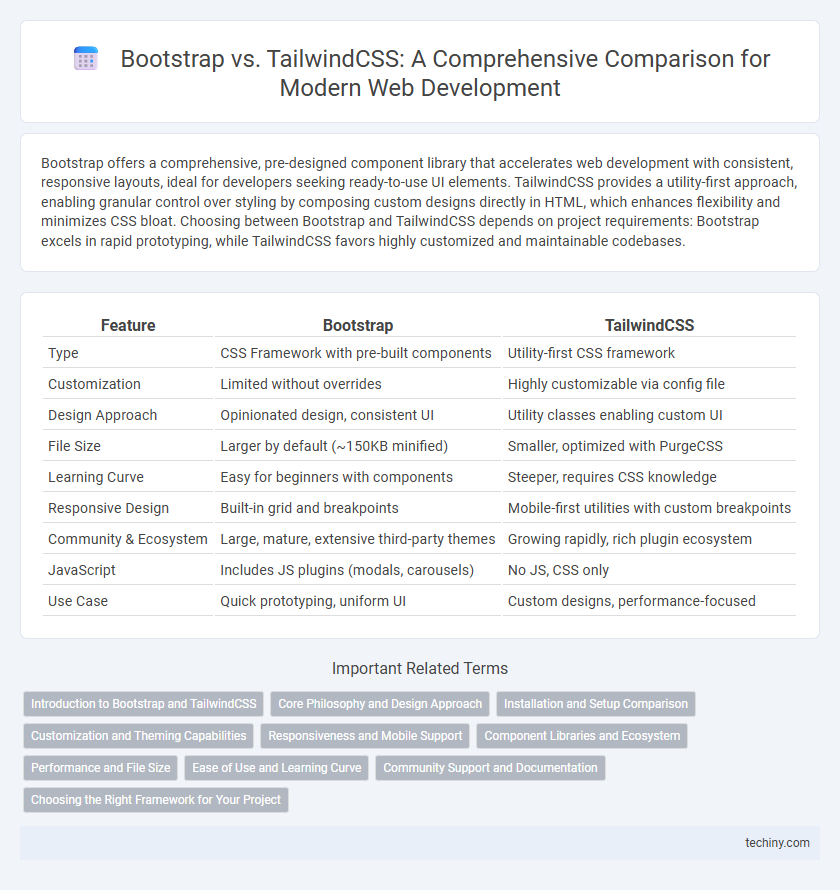Bootstrap offers a comprehensive, pre-designed component library that accelerates web development with consistent, responsive layouts, ideal for developers seeking ready-to-use UI elements. TailwindCSS provides a utility-first approach, enabling granular control over styling by composing custom designs directly in HTML, which enhances flexibility and minimizes CSS bloat. Choosing between Bootstrap and TailwindCSS depends on project requirements: Bootstrap excels in rapid prototyping, while TailwindCSS favors highly customized and maintainable codebases.
Table of Comparison
| Feature | Bootstrap | TailwindCSS |
|---|---|---|
| Type | CSS Framework with pre-built components | Utility-first CSS framework |
| Customization | Limited without overrides | Highly customizable via config file |
| Design Approach | Opinionated design, consistent UI | Utility classes enabling custom UI |
| File Size | Larger by default (~150KB minified) | Smaller, optimized with PurgeCSS |
| Learning Curve | Easy for beginners with components | Steeper, requires CSS knowledge |
| Responsive Design | Built-in grid and breakpoints | Mobile-first utilities with custom breakpoints |
| Community & Ecosystem | Large, mature, extensive third-party themes | Growing rapidly, rich plugin ecosystem |
| JavaScript | Includes JS plugins (modals, carousels) | No JS, CSS only |
| Use Case | Quick prototyping, uniform UI | Custom designs, performance-focused |
Introduction to Bootstrap and TailwindCSS
Bootstrap is a widely-used CSS framework offering pre-designed components and responsive grid systems to streamline web development with consistent styling. TailwindCSS provides a utility-first approach, enabling developers to customize designs directly in the HTML through atomic classes, promoting flexibility and minimal CSS output. Both frameworks aim to accelerate UI building, but Bootstrap emphasizes ready-made components while TailwindCSS prioritizes design control and customization.
Core Philosophy and Design Approach
Bootstrap employs a component-based design system with pre-styled UI elements aiming for rapid development and consistent appearance, while TailwindCSS follows a utility-first approach that offers low-level utility classes to build custom designs directly in the HTML. Bootstrap's core philosophy centers on providing ready-made, opinionated components promoting uniformity across projects, whereas TailwindCSS emphasizes flexibility and atomic styling, enabling developers to create unique interfaces without overriding default styles. TailwindCSS encourages responsive design through easily composable utility classes, contrasting Bootstrap's reliance on a predefined grid and component responsiveness.
Installation and Setup Comparison
Bootstrap offers a straightforward installation process via CDN, npm, or downloading the source files, making it accessible for beginners and allowing quick integration. TailwindCSS requires a more involved setup with Node.js, PostCSS, and a build process, but it provides greater customization and flexibility in styling. While Bootstrap has predefined components ready to use out-of-the-box, TailwindCSS emphasizes utility-first CSS classes, demanding initial configuration but enabling more granular control over design systems.
Customization and Theming Capabilities
Bootstrap offers a robust theming system with predefined components and a traditional CSS framework that simplifies customization through Sass variables and utility classes. TailwindCSS excels in customization by providing a highly configurable utility-first approach, enabling developers to create unique designs with minimal CSS overrides and extend themes via its configuration file. Tailwind's flexibility in theming surpasses Bootstrap's, allowing for granular control over colors, spacing, and typography without the constraints of pre-styled components.
Responsiveness and Mobile Support
Bootstrap offers a comprehensive grid system and pre-built responsive components that simplify mobile-first web development, ensuring consistent layouts across devices. TailwindCSS provides utility-first classes that enable custom responsive designs with fine-grained control over breakpoints and styling, optimizing mobile experiences without heavy reliance on predefined components. Both frameworks support mobile responsiveness effectively, but TailwindCSS excels in flexibility and smaller bundle sizes, enhancing performance on mobile devices.
Component Libraries and Ecosystem
Bootstrap offers a comprehensive component library with pre-designed, responsive UI elements that accelerate development, making it ideal for projects needing ready-made solutions. TailwindCSS emphasizes utility-first styling, relying on third-party component libraries like Headless UI or Flowbite to provide reusable components, which allows for greater customization and flexibility. The Bootstrap ecosystem includes extensive documentation and integrated JavaScript plugins, while Tailwind's ecosystem thrives on modularity and community-driven resources, fostering a more adaptable development environment.
Performance and File Size
Bootstrap delivers prebuilt components with a larger default CSS file, often exceeding 150KB, which can impact load times and overall performance. TailwindCSS offers a utility-first approach with a smaller base file size typically under 30KB, further minimized through purging unused styles during production builds. This leaner footprint in TailwindCSS enhances page speed and reduces rendering delays compared to Bootstrap's comprehensive but bulkier framework.
Ease of Use and Learning Curve
Bootstrap offers a more straightforward learning curve with pre-designed components and extensive documentation, making it easier for beginners to quickly build responsive websites. TailwindCSS requires understanding utility-first classes and customization, which can be challenging initially but provides greater flexibility and control once mastered. Developers aiming for rapid prototyping often prefer Bootstrap, while those seeking highly customizable designs tend to choose TailwindCSS despite its steeper learning curve.
Community Support and Documentation
Bootstrap offers extensive community support with a large, active user base and comprehensive, well-structured documentation that includes examples, components, and customization guidelines. TailwindCSS has rapidly growing community engagement and detailed documentation emphasizing utility-first design, with interactive examples and thorough configuration options. Both frameworks provide valuable resources, but Bootstrap's longer presence ensures broader third-party tutorials and plugins.
Choosing the Right Framework for Your Project
Bootstrap offers a comprehensive set of pre-designed components and a grid system ideal for quickly building responsive websites, making it suitable for projects requiring rapid development with consistent styling. TailwindCSS provides a utility-first approach that enables developers to create highly customizable designs by composing low-level classes, offering greater flexibility for unique and scalable user interfaces. Choosing the right framework depends on your project's needs: opt for Bootstrap if you prefer structured components and faster prototyping, or TailwindCSS for tailored design control and minimalist CSS output.
Bootstrap vs TailwindCSS Infographic

 techiny.com
techiny.com